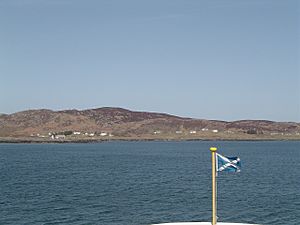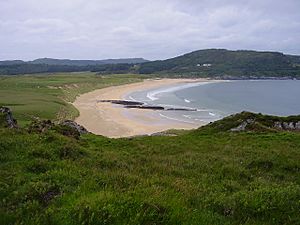Colonsay facts for kids
| Gaelic name | Colbhasa |
|---|---|
| Norse name | Colonsey |
| Meaning of name | Old Norse for 'Columba's isle' |
| OS grid reference | NR382938 |
| Coordinates | 56°04′N 6°13′W / 56.06°N 6.21°W |
| Physical geography | |
| Island group | Islay |
| Area | 4,074 ha (15+3⁄4 sq mi) |
| Area rank | 26 |
| Highest elevation | 143 m (469 ft) |
| Administration | |
| Sovereign state | United Kingdom |
| Country | Scotland |
| Council area | Argyll and Bute |
| Demographics | |
| Population | 124 |
| Population density | 2.7/km2 (7.0/sq mi) |
| Largest settlement | Scalasaig |
Colonsay (which means 'Columba's island' in Old Norse) is a beautiful island in Scotland. It is part of the Inner Hebrides group of islands. You can find it north of Islay and south of Mull.
Colonsay is the historic home of two Scottish clans: Clan Macfie and a branch of Clan MacNeil. The island is part of the Argyll and Bute council area. It covers an area of about 4,074 hectares (15.7 square miles). The island stretches about 8 miles (13 km) long and is up to 3 miles (4.8 km) wide.
Contents
- Island Geology: How Colonsay Was Formed
- Island Geography: Exploring Colonsay
- Island History: A Look Back in Time
- Colonsay Today: Life on the Island
- Getting There: Island Transport
- Arts and Culture: Island Creativity
- Island Wildlife: Nature's Wonders
- Island Names: What They Mean
- Island Climate: Colonsay's Weather
- Images for kids
- See also
Island Geology: How Colonsay Was Formed
Colonsay is known for its special rocks, which scientists call the Colonsay Group. These rocks are very old, about 500 million years old! They are made of sedimentary rocks, which are formed from layers of sand and mud over millions of years. You can also find these rocks on nearby islands like Islay and Oronsay.
The island also has igneous rocks. These rocks are formed from cooled lava or magma. You can see them in places like Scalasaig and Balnahard. There are also many geological faults (cracks in the Earth's crust) that run across the island.
On top of these old rocks, you can find more recent layers. These include sandy beaches, old raised beaches (which were once at sea level), and areas of peat. Peat is a type of soil made from decayed plants, formed after the last ice age.
Island Geography: Exploring Colonsay
From the sea, Colonsay might look a bit wild. But if you explore, you'll find a varied landscape. It has many lovely sandy beaches and a green, fertile area inside the island. It's also quite wooded, which is unusual for a Hebridean island.
Colonsay is connected to the smaller island of Oronsay by a natural causeway called The Strand. You can walk across it at low tide! The highest point on Colonsay is Carnan Eoin, which is 143 meters (469 feet) above sea level.
Island History: A Look Back in Time
Ancient Food Industry: Hazelnut Feast
In 1995, archaeologists found something amazing on Colonsay. They discovered evidence of a huge hazelnut processing site from about 8,000 years ago! This was during the Mesolithic period (Middle Stone Age). They found a large pit filled with hundreds of thousands of burned hazelnut shells.
This discovery shows that people living on Colonsay long ago were very organized. They harvested a massive amount of hazelnuts in one year. Scientists think the hazelnut trees were cut down at the same time. Because there wasn't much large game (animals for hunting) on the island, it seems the people of Colonsay mostly ate plants.
Early Settlements and Churches
Colonsay has several old ruined hill forts. These include Dùn Cholla and Dùn Meadhonach. These forts were likely used for defense a long time ago.
You can also see old religious sites. The Riasg Buidhe Cross, which is from the 8th century, stands in the gardens of Colonsay House. The ruins of St Cathan's Chapel might be from the 14th century. The Chapel of St. Mary is even older, with only its foundations remaining.
In 1549, a writer named Dean Monro described Colonsay as a fertile island. He said it was good for fishing and had a parish church.
Island Ownership: Colonsay House
In the 1700s, the MacNeil family owned Colonsay. They built Colonsay House in 1722.
Since 1904, the house has belonged to the Barons Strathcona and Mount Royal. Today, Alexander Howard, 5th Baron Strathcona and Mount Royal and his family live there.
Colonsay Today: Life on the Island
The island's population was 124 people in 2011. This was a small increase from 2001. The main village on Colonsay is Scalasaig, located on the east coast. Its name comes from Old Norse and means "Skali's bay."
Tourism is very important to Colonsay's economy. Many holiday cottages are available for visitors. The Colonsay Hotel is the only hotel on the island.
Colonsay has a small bookshop that focuses on local books. It's also home to a publishing company called House of Lochar. The hotel overlooks the harbor, and there's also a cafe, bakery, shop, and post office. Kiloran Bay is the island's most famous beach. It has golden sands and is a peaceful spot for locals and tourists.
The Colonsay Community Development Company works to improve the island. They manage the island's coal supply and only petrol pump. They also work on removing a plant called Rhododendron ponticum and are looking into improving the harbor.

In 2007, the Colonsay Brewery opened. It's a small brewery that makes different drinks. Colonsay is known as the smallest island in the world with its own brewery! In 2016, they started making a gin called Wild Island Botanic Gin.
Colonsay is known for being a very peaceful place. It's said that the last recorded serious crime on the island was a very long time ago, in 1623! The island has even hosted a rugby festival, which is quite special since there isn't a permanent rugby pitch.
Getting There: Island Transport
Caledonian MacBrayne ferries connect Colonsay to Oban on the mainland. Between April and October, ferries also sail to Kennacraig via Port Askaig on Islay.
In 2006, the island's grass airstrip was upgraded with a hard surface. Now, Hebridean Air Services offers scheduled flights to Colonsay Airport from Oban Airport and Islay Airport.
| Preceding station | Ferry | Following station | ||
|---|---|---|---|---|
| Oban | Caledonian MacBrayne Ferry |
Port Askaig (limited service) |
Arts and Culture: Island Creativity
The 1945 film I Know Where I'm Going! was filmed mostly on Mull. It features a fictional "Isle of Kiloran," which was inspired by Colonsay. The American author John McPhee also wrote a book about his summer on Colonsay called The Crofter and the Laird.
Since 2008, Colonsay has hosted Ceòl Cholasa, its own folk music festival. This is an annual event that features famous musicians and local talent.
The island also holds a "Festival of Spring" every May. This event encourages tourism and includes activities led by locals and guest experts. A similar event, "Connect with Colonsay," happens in October.
Since 2012, Colonsay has had an annual book festival. Famous writers like Alexander McCall Smith and Ian Rankin have attended.
Island Wildlife: Nature's Wonders
Colonsay is home to a herd of wild goats. It's also a great place for birdwatching. You might see black-legged kittiwakes, cormorants, guillemots, corncrakes, and even golden eagles.
Colonsay and Oronsay are special because they are home to about 50 colonies of the European dark bee (Apis mellifera mellifera). To protect these unique bees, the Scottish Government made a rule in 2014. It is now against the law to keep any other type of honeybee on either island. This helps prevent the dark bees from mixing with other bees and protects them from diseases. These bees are now called the "Colonsay Dark Native Bee."
Island Names: What They Mean
The name Colonsay comes from an old language called Old Norse. It means "Kolbein's island." Some people also think it might mean "Columba's island," after a saint. In the 14th century, it was called Coluynsay. The modern Gaelic name is Colbhasa. The main village, Scalasaig, also has a Norse name, meaning "Skali's bay."
Island Climate: Colonsay's Weather
Colonsay has an oceanic climate, which means it has mild temperatures and rain throughout the year.
| Climate data for Colonsay Homefield (9 m asl, averages 1981–2010) | |||||||||||||
|---|---|---|---|---|---|---|---|---|---|---|---|---|---|
| Month | Jan | Feb | Mar | Apr | May | Jun | Jul | Aug | Sep | Oct | Nov | Dec | Year |
| Mean daily maximum °C (°F) | 7.9 (46.2) |
7.7 (45.9) |
9.0 (48.2) |
10.8 (51.4) |
13.6 (56.5) |
15.4 (59.7) |
17.0 (62.6) |
17.0 (62.6) |
15.6 (60.1) |
12.8 (55.0) |
10.2 (50.4) |
8.5 (47.3) |
12.2 (54.0) |
| Mean daily minimum °C (°F) | 3.4 (38.1) |
3.1 (37.6) |
4.0 (39.2) |
5.0 (41.0) |
7.1 (44.8) |
9.5 (49.1) |
11.2 (52.2) |
11.5 (52.7) |
10.2 (50.4) |
8.0 (46.4) |
5.6 (42.1) |
3.8 (38.8) |
6.9 (44.4) |
| Average rainfall mm (inches) | 116.4 (4.58) |
84.7 (3.33) |
97.6 (3.84) |
64.5 (2.54) |
64.4 (2.54) |
69.8 (2.75) |
77.6 (3.06) |
86.7 (3.41) |
118.5 (4.67) |
114.1 (4.49) |
122.2 (4.81) |
126.3 (4.97) |
1,142.6 (44.98) |
| Average rainy days (≥ 1 mm) | 19.7 | 14.9 | 15.4 | 12.3 | 10.5 | 10.9 | 13.7 | 15.0 | 15.8 | 18.3 | 18.8 | 17.5 | 182.8 |
| Mean monthly sunshine hours | 39.6 | 76.2 | 113.7 | 172.7 | 217.6 | 177.4 | 160.3 | 165.0 | 124.4 | 88.4 | 44.7 | 31.3 | 1,411.3 |
| Source: Met Office | |||||||||||||
Images for kids
See also
 In Spanish: Colonsay para niños
In Spanish: Colonsay para niños







